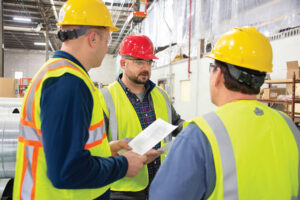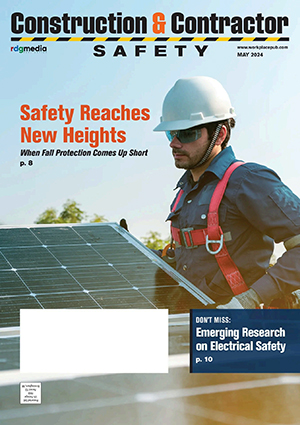Protecting New Employees with the Four Ps of Safety
By: Cindy Pauley, Contributor

New employees should be encouraged to ask questions if they’re unsure of how to handle a situation. Image courtesy of J. J. Keller & Associates.
Employers should help workers understand the four Ps of safety — people, places, personal protective equipment (PPE) and personal accountability. A new job is stressful enough, but adding all new safety rules to unfamiliar surroundings can create serious anxiety for new employees. Walking newbies through these four safety components as a supplement to safety and regulatory training will help ease their anxiety so they can focus on their new role.
New employees are typically eager to get started and are more focused on the nuances of their new surroundings. They have a set of fresh eyes to risks or hazards, so employers shouldn’t just speak to them but ask them questions about what they see. This allows employers to capitalize on the information to improve safety and build a positive culture.
People
New employees should take time to get to know coworkers by asking them about the workplace, hazards and common tasks. They can learn a great deal from seasoned front-line workers about how to identify and respond to special circumstances or common challenges that arise. Coworkers are a great source for bouncing off new ideas, safety suggestions and clarifying training points that rookies are trying to absorb.
There is also a personal side to getting to know people in the workplace. Recognizing coworker schedules and work habits helps newbies know where others are in case assistance is needed during emergencies or to help account for coworkers during emergencies.
Showing an interest in coworker hobbies, joys and family not only builds camaraderie but strengthens the safety culture. Compassion grows when workers get to know one another on a more personal level. And that compassion motivates safer behavior and a desire to ensure the safety of others when it’s needed most.
Places
Once trained on safety protocols and any special rules for the worksite, new hires should walk around the work area to familiarize themselves with emergency response equipment, first aid and eyewash stations, machinery, processes and vehicles. They should observe hazards in and around their personal workspace and communicate with coworkers about hazards.
While on the facility tour, newbies should remain mindful of in-process work, looking both ways, yielding to vehicles and using caution before stepping out of designated walkways. Time should be taken to observe egresses and exits, stairways and pedestrian pathways. New employees should note where shelter locations are and where employees are expected to gather during an evacuation.
New employees should gain a visual understanding of hazardous areas, special machine guarding such as light curtains, electrical panels, moving equipment and other indications of restricted entry. They will also be interested in areas for eating and taking rest breaks, as well as restroom facilities and other designated areas.
PPE
PPE is intended to minimize exposure to hazards in the workplace. It’s the last line of defense, following engineering and administrative controls, for preventing worker injuries and illnesses. PPE protects workers from chemical, electrical, physical and mechanical hazards.
New employees should understand when PPE is required, what kind is best for individual tasks, how to properly wear the PPE, limitations of their protective equipment and how to care for it. PPE is not intended to make a task more difficult, but to protect from dangers. If PPE doesn’t fit properly, isn’t easily accessible or doesn’t seem to protect sufficiently, employees should notify a supervisor immediately. It’s better to say something than lose something!
The best message for new employees about PPE is … the worst kind of PPE is the kind that’s not worn.
Personal Accountability
Safety starts and ends with personal accountability. Yes, the employer is required to maintain a workplace that’s free of recognized hazards. However, each employee plays a role in maintaining that safe work environment. This is especially true for newcomers who are not yet comfortable with processes, procedures, equipment or each other.
An employer can offer the best training, top-of-the-line PPE and the most modern equipment around, but if employees aren’t actively involved, it’s meaningless. Failure to follow training and procedures, not looking out for new or unexpected hazards or taking shortcuts can be disastrous, or even fatal.
Workplace newcomers should actively participate in training by asking questions and giving their undivided attention. It’s important that employees understand why PPE, rules and safety protocols are required — to save lives and limbs. New employees should be encouraged to ask questions if they’re unsure of how to handle a situation. Staying vigilant of workplace hazards such as energized equipment, slip and fall hazards, restricted areas and moving vehicles is a must for all workers, but especially new employees.
Employers must remember that new employees are trying to absorb a great deal of information, while still working safely and being productive. By helping them understand the four P’s of safety — people, places, PPE and personal accountability — they’re better equipped to blend seamlessly and safely into their new workplace.
Cindy Pauley is an Editor for J. J. Keller & Associates, Inc. on the Environmental, Health & Safety (EHS) Publishing Team. She utilizes her 13+ years of safety program development and management experience in the oil and gas, chemical, manufacturing, construction and agricultural industries to develop a wide variety of easily understandable content and to provide regulatory insight for J. J. Keller & Associates’ customers and partners. Cindy is a Certified Occupational Safety Specialist (COSS) and a Certified Occupational Hearing Conservationist (COHC). (www.jjkeller.com) WMHS



